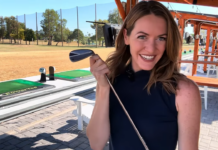 While the grip is often referred to as a fundamental to playing the game of golf, I tend to disagree. The only aspect of the grip that is fundamental is that every golfer must have one, anything beyond this is a variable that the golfer utilizes to help them create their preferred shot pattern. If you were to conduct a study of the various full swing grip styles on the professional tours you would find strong grips, weak grips, overlapping, interlocking, and even lead hand low. All of these grips would have been chosen by the golfer to help them produce their preferred ball flight pattern in a repeatable fashion.
While the grip is often referred to as a fundamental to playing the game of golf, I tend to disagree. The only aspect of the grip that is fundamental is that every golfer must have one, anything beyond this is a variable that the golfer utilizes to help them create their preferred shot pattern. If you were to conduct a study of the various full swing grip styles on the professional tours you would find strong grips, weak grips, overlapping, interlocking, and even lead hand low. All of these grips would have been chosen by the golfer to help them produce their preferred ball flight pattern in a repeatable fashion.
It comes as no surprise that the average golfer often battles with slicing the ball, especially with their longer clubs. This slice is caused when the clubface is open to the club path and often open to the target as well. I typically find that for these students, the best game plan is first to address the open clubface and then begin to redirect their swing as needed.
The two main variables that must be addressed to close the clubface to the path are the orientation of the lead wrist (left wrist for a right-handed golfer) at address and the torque applied about the axis of the shaft via the wrists. Let’s first talk about how the golfer can correctly torque the shaft to close the clubface the most.
The right-handed golfer must apply a counter-clockwise torque about the axis of the shaft during the downswing, helping to close the clubface relative to the club path. The greater the amount of torque and the longer it is applied, the more the club-face will close. The golfer will do this by palmar flexing or downward bowing the lead wrist relative to its address orientation. To help practice this motion, place a screwdriver in your left hand and simply practice making the motion for loosening a screw, as shown in the graphic below.

The orientation of the lead wrist at address will determine how many degrees of motion the golfer can torque the shaft. By dorsiflexing the lead wrist the most at address, the golfer will have the greatest range of motion to then palmar flex during the downswing and apply a counter-clockwise torque to the shaft. To practice this motion, take your normal grip and turn your lead hand until you can see two or three knuckles, illustrated at right in the image below.

The more that the lead wrist is turned and the more the golfer torques the shaft counter-clockwise during the downswing, the more likely they will draw the ball. See the image below illustrating the difference in clubface during the downswing with the palmer flexion described throughout this article. Through practice and repetition, you will be able to calibrate how much of each variable needs to be applied to successfully create this desired shot pattern.

If you continue to struggle slicing the golf ball, talk to your local GolfTEC Coach for additional drills and techniques to help today.









